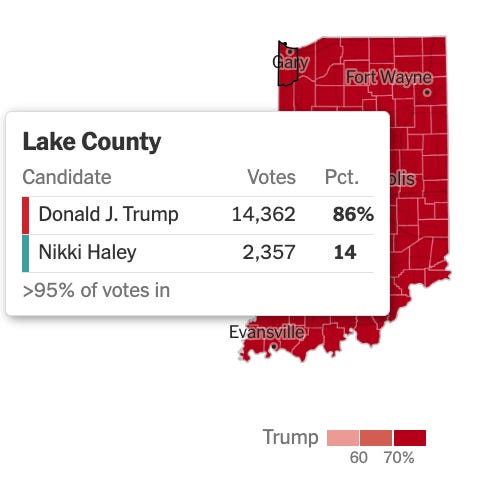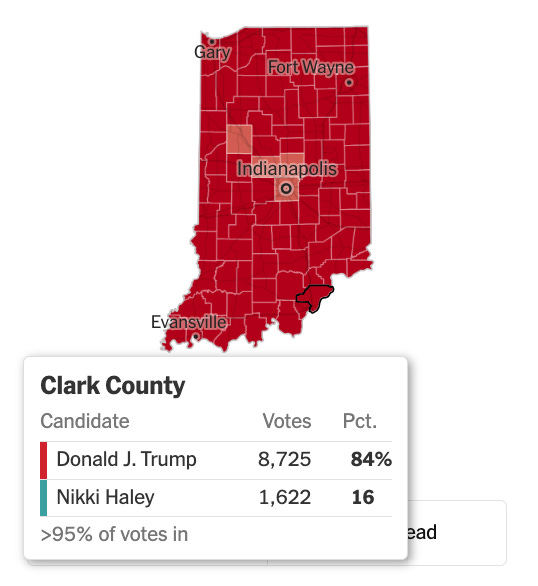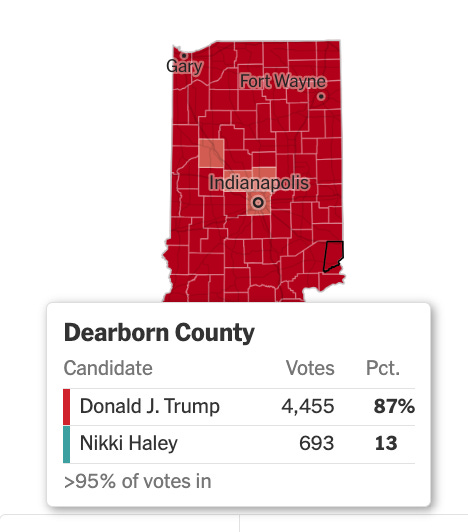About that Haley 22% in Indiana
It's not that she got so much, it's where she got her support in rock-ribbed Indiana

Indiana, the “Crossroads of America”, delivered yet another political surprise in the quietest of ways this week — revealing the shape of the modern Republican Party in a way few other 2024 contests have thus far.
Former U.N. Ambassador Nikki Haley won 22% of the vote in Indiana’s Republican primary against presumptive nominee Donald Trump, another sign of the Republican Party leader’s surprising weakness in his own party. (Yes, I saw the floats that maybe this was a secret Democratic effort to swamp the polls and pull Republican ballots — but the clearest indication that is incorrect is that Trump himself performed *best* in Democratic strongholds. More on that below.)
Don’t take that as a sign that Democrats will all the sudden win statewide in Indiana in November, or that the Hoosier State all the sudden is having an ‘08 Obama moment.
Instead, Tuesday’s election results were a look into the state of the Republican Party still undergoing a massive geographic shift — which started with Richard Nixon’s Southern Strategy, and has accelerated under GOP leaders like Ronald Reagan and Trump.
And this has been a repeated issue in the Republican primaries.
When Haley dropped out of the race two months ago, she cautioned the men at the top of the Republican and Democratic tickets they would have to win over her supporters. In Florida a few weeks later, Haley won a surprising 13.9% of the vote. (Former GOP favorite and Florida Gov. Ron DeSantis only scored 3.7%, whereas Trump claimed 81.2% of the vote.)
Since then, neither Trump nor Biden seems to have made a dent in that coalition of old-line conservatives and suburban moderates who could easily determine the election in November. (For more on that, check out the 24sight Pod Episode 10, with Republican Voters Against Trump.)
Haley performed similarly strong in the critical battleground state of Wisconsin. And also in Georgia, where Trump’s handpicked candidates in the 2022 midterms fell to mainline conservatives who bucked his baseless efforts to overturn the 2020 election.
But in Indiana, long a bedrock of the Republican Party, Haley won a whopping 22% percent of the Republican primary vote.
Remember, one of the principal reasons Trump picked former Vice President Mike Pence in the first place was because he could repair the breach with lifelong social conservatives and Midwesterners that Trump’s campaign was worried would stay home that November rather than vote for Trump.
Eight years later, the same dilemma persists.
Follow along for in-depth analysis of why this matters, available to paying subscribers of 24sight News. (This is one of the added perks for paying subscribers, if you like our work and are currently free - please look at buying a subscription and supporting in-depth reporting.)
Screenshots below are from the New York Times map of Indiana’s results.
Let’s follow along piece by piece.
Hamilton County, the moneyed burbs
This is exactly where one would expect Haley to do the best, and that she did. She pulled in a stunning 34% to Trump’s 66%.
Yes, I hear you, possible secret Democratic votes switching sides — Indiana doesn’t have party registration and party ID is determined by the last primary someone voted in. But there’s no indication of that writ-large.
Instead, Haley seems to have performed exceptionally well in this moderate-conservative enclave to the north of Indianapolis.
Lake County, Democratic stronghold
You know the old line about vote early and vote often, from the Richard J. Daley machine, among others. Lake County is southern suburb, exurb of Chicago — and Trump overperformed here compared to the rest of the state.
Trump got 86% and Haley 14%.
With Trump plying at former Democrats and blue-collar workers, this is exactly what you would expect. A lot of the Republicans up here are former Dems, “Reagan Democrats”, as politicos used to say.
Again, unsurprising.
The surprises are in the pockets of Indiana which generally get overlooked.
So let’s get to them.
Johnson County, conservative underdog of the burbs
The biggest suburb to the south of Indianapolis, often considered something of an underdog to the moneyed burbs to the north, tracks closely with the results statewide.
Trump got 77% and Haley 23%.
There’s certainly a blue-collar, manufacturing former Democratic element to the voting base here. But also plenty of rural voters and what used to be called mainline conservative voters.
This starts to get at the split in the GOP and what it can tell us heading in to November.
Clark County, Butternut Dems for Trump
In this southern Indiana county, which encompasses some of the bedroom communities of Louisville, Kentucky — across the Ohio River — Democrats used to score legacy wins not too long ago, vestiges of the old South.
Now it looks more like the current Trump Republican Party coalition.
Trump got 84% and Haley 16%.
Dearborn County, a similar exurb
Trump performed even better in rural Dearborn County, which used to have deep roots with Democrats and is something of an exurb of the fairly conservative Cincinnati across the river.
Trump got 87% and Haley 13%.
But Indiana has historically been a state associated with legacy Republicans and deep ties to the conservative movement which arose after Barry Goldwater.
So what of one of those traditional Republican Party bastions?
Allen County, Legacy Republicans
The home to Fort Wayne Indiana, with deep ties to the German and Dutch Reform settlers who make up the “Michiana” region up by the Michigan border, with large populations of Mennonite and Amish practitioner delivered a surprisingly strong showing for Haley - in line with the statewide surprise.
Trump got 77% and Haley got 23%.
See something I missed, disagree, love it? Drop me a note: tom@24sight.news
Love all things Hoosierland.








